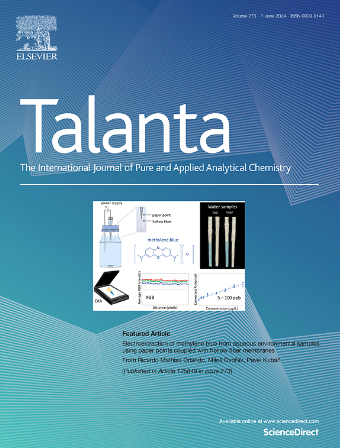Zirconium-doped iron oxide nanoparticles for enhanced peroxidase-like activity
IF 6.1
1区 化学
Q1 CHEMISTRY, ANALYTICAL
引用次数: 0
Abstract
Fe3O4 nanoparticles (NPs) have emerged as pioneering nanozymes with applications in clinical diagnosis, environmental protection and biosensing. However, it is currently limited by insufficient catalytic activity due to poor electron transfer. In this study, we synthesized electron-rich-Zr-doped defect-rich Fe3O4 NPs (Zr3Fe3O4) using a one-pot solvothermal method. Compared with intrinsic Fe3O4 NPs, the resultant Zr3Fe3O4 NPs exhibit enhanced peroxidase (POD)-like activity attributed to the presence of active centers of Zr-O-Fe bridges and adsorption sites of asymmetric oxygen vacancies (OVs) Zr-OVs-Fe. The Zr-O-Fe bridges facilitate electron transfer from Zr to Fe, promoting the regeneration of surface Fe2+ in Fe3O4 NPs. Furthermore, the rich Zr-OVs-Fe significantly enhances the adsorption and electron transfer between catalyst and substrates, thereby regulating the generation pathway of 1O2. Leveraging the remarkable POD-like activity of Zr3Fe3O4 NPs, we developed a tandem enzyme-catalyzed reaction for colorimetric detection of glucose. This strategy of constructing active centers by atom doping provides valuable guidance for the development of more efficient Fenton-like catalytic systems with broad applications on a large scale.

锆掺杂氧化铁纳米颗粒增强过氧化物酶样活性。
Fe3O4纳米颗粒(NPs)作为一种开创性的纳米酶在临床诊断、环境保护和生物传感方面有着广泛的应用。然而,目前由于电子转移差,催化活性不足而受到限制。在本研究中,我们采用一锅溶剂热法合成了富电子掺杂富缺陷的Fe3O4 NPs (Zr3Fe3O4)。与固有的Fe3O4 NPs相比,合成的Zr3Fe3O4 NPs由于存在Zr-O-Fe桥的活性中心和不对称氧空位(OVs) Zr-OVs-Fe的吸附位点而表现出增强的过氧化物酶(POD)样活性。Zr- o -Fe桥促进了电子从Zr到Fe的转移,促进了Fe3O4 NPs中表面Fe2+的再生。此外,富含的Zr-OVs-Fe显著增强了催化剂与底物之间的吸附和电子转移,从而调节了1O2的生成途径。利用Zr3Fe3O4 NPs显著的pod样活性,我们开发了一种串联酶催化反应用于葡萄糖的比色检测。这种通过原子掺杂构建活性中心的策略为开发更高效、具有广泛应用前景的类芬顿催化体系提供了有价值的指导。
本文章由计算机程序翻译,如有差异,请以英文原文为准。
求助全文
约1分钟内获得全文
求助全文
来源期刊

Talanta
化学-分析化学
CiteScore
12.30
自引率
4.90%
发文量
861
审稿时长
29 days
期刊介绍:
Talanta provides a forum for the publication of original research papers, short communications, and critical reviews in all branches of pure and applied analytical chemistry. Papers are evaluated based on established guidelines, including the fundamental nature of the study, scientific novelty, substantial improvement or advantage over existing technology or methods, and demonstrated analytical applicability. Original research papers on fundamental studies, and on novel sensor and instrumentation developments, are encouraged. Novel or improved applications in areas such as clinical and biological chemistry, environmental analysis, geochemistry, materials science and engineering, and analytical platforms for omics development are welcome.
Analytical performance of methods should be determined, including interference and matrix effects, and methods should be validated by comparison with a standard method, or analysis of a certified reference material. Simple spiking recoveries may not be sufficient. The developed method should especially comprise information on selectivity, sensitivity, detection limits, accuracy, and reliability. However, applying official validation or robustness studies to a routine method or technique does not necessarily constitute novelty. Proper statistical treatment of the data should be provided. Relevant literature should be cited, including related publications by the authors, and authors should discuss how their proposed methodology compares with previously reported methods.
 求助内容:
求助内容: 应助结果提醒方式:
应助结果提醒方式:


